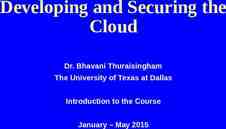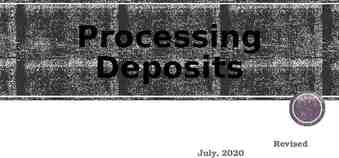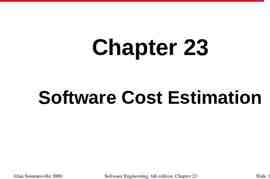BRACHIAL PLEXUS Dr. Kumar Satish Ravi MBBS,MD(JIPMER),MAMS
54 Slides5.21 MB
BRACHIAL PLEXUS Dr. Kumar Satish Ravi MBBS,MD(JIPMER),MAMS Sub-Dean (Academics) & Additional Proctor, AIIMS Rishikesh
Objectives Spinal Nerves Nerve Plexus BP – Origin & Relations Formation Parts of BP Distribution - Nerve Supply – areas Anatomical Variations Applied Anatomy Dr.Ravi 02/29/2024 2
Spinal Nerves Spinal nerves attach to the spinal cord via roots Dorsal root Has only sensory neurons Attached to cord via rootlets Dorsal root ganglion Ventral root Has only motor neurons No ganglion - all cell bodies of motor neurons found in gray matter of spinal cord Dr.Ravi 02/29/2024 3
Spinal Nerves 31 pair each contains thousands of nerve fibers All are mixed nerves have both sensory and motor neurons Connect to the spinal cord Exit from SC – Supplying the muscles & structures of the body Dr.Ravi 02/29/2024 4
Spinal Nerves 8 pairs of cervical nerves from C1 to C8 12 pairs of thoracic nerves from T1-T12 5 pairs of lumbar nerves from L1 to L5 5 pairs of sacral nerves from S1 to S5 1 pair of coccygeal nerves located at C zero (Co) Dr.Ravi 02/29/2024 5
Formation of Rami Rami are lateral branches of a spinal nerve Rami contain both sensory and motor neurons Two major groups Dorsal ramus Neurons innervate the dorsal regions of the body Ventral ramus Larger Neurons innervate the ventral regions of the body Braid together to form plexuses (plexi) Dr.Ravi 02/29/2024 6
Nerve Plexuses Nerve plexus A nerve plexus is nothing more than a system or network of connected nerve fibers that link spinal nerves with specific areas of the body . A network of ventral rami. Ventral rami (except T2-T12) Branch and join with one another Form nerve plexuses In cervical, brachial, lumbar, and sacral No plexus formed in thoracic region of regions Dr.Ravi 02/29/2024 7
Branches of Spinal Nerves Dorsal Ramus Neurons within muscles of trunk and back Ventral Ramus (VR) Braid together to form plexuses Cervical plexus - VR of C1-C4 Brachial plexus - VR of C5-T1 Lumbar plexus - VR of L1-L4 Sacral plexus - VR of L4-S4 Coccygeal plexus -VR of S4&S5 Communicating Rami: communicate Covered with sympathetic chain of ganglia in ANS unit 12-8 Dr.Ravi 02/29/2024 8
Brachial Plexus - Origin Formed by ventral rami of spinal nerves C5-T1 Five ventral rami form Roots / Trunks that separate into Divisions that then form Cords that give rise to Branches Major nerves Axillary Radial Musculocutaneous Ulnar Median Dr.Ravi 02/29/2024 9
Brachial Plexus 15 cms long ,spinal column to axilla. Brachial plexus is responsible for cutaneous (sensory) and muscular (motor) innervation of the entire upper limb & pectoral girdle. It proceeds through the neck, the axilla and into the arm. Dr.Ravi 02/29/2024 10
Dr.Ravi 02/29/2024 11
Relations - BP In neck- posterior triangle, being covered by skin, Platysma, & deep fascia; where it is crossed by supraclavicular nerves, inferior belly of Omohyoid, external jugular vein, & transverse cervical artery. Dr.Ravi 02/29/2024 12
Relations - BP When it emerges between Scalene anterior & medius --* its upper part lies above 3rd part of subclavian artery, * while trunk formed by union of C8 & T1 is placed behind artery. Dr.Ravi 02/29/2024 13
Relations - BP Plexus next passes behind clavicle, Subclavius, & transverse scapular vessels, & lies upon 1st digitation of Serratus anterior, & Subscapularis. Dr.Ravi 02/29/2024 14
Relations In axilla it is placed lateral to first portion of axillary artery; it surrounds 2nd part of artery, one cord lying medial to it, one lateral to it, and one behind it; at lower part of the axilla it gives off its terminal branches to upper limb. Dr.Ravi 02/29/2024 15
TRUNK ROOT Dorsal scapular N. C4 Suprascapular N. C5 Lateral pectoral L A ER T LA AD D R CO PD PD Anatomy CORD & BRANCH DIVISION AD PD UT C6 N.subclavius MT C7 OUS D E N C8 R A T U O C O P C L U D C T MUS OR LT I O R E T OS RO P L AD A T1 R AXILLARY R E O EAT V C R L E N. to latissimus L 2 LN T A A I I dorsi D RAD MEDIAL ROO E T M E V R U. Subscapular NE Long thoracic R N A A N VE I L L. Subscapular U ER MCF MCA Medial pectoral ED 16 Dr.Ravi 02/29/2024 N M
Brachial Plexus Branches Dr.Ravi 02/29/2024 17
Brachial Plexus Branches Branches of the Roots Long thoracic nerve(C5,C6,C7) Dorsal scapular nerve(C5) N. to longus colli & scaleni Branches of Trunks Suprascapular nerve(C5,C6) Nerve to subclavius(C5,C6) Branches of Lateral Cord Lateral Pectoral (C5-C7) Musculocutaneous (C5-C7) Lateral root of Median Nerve (C5-C7) Dr.Ravi 02/29/2024 18
Brachial Plexus Branches Branches of Medial Cord Medial pectoral(C8-T1) Medial cutaneous nerve of arm(C8-T1) Medial cutaneous nerve of forearm(C8-T1) Ulnar nerve(C7,C8,T1) Medial root of median nerve(C8-T1) Branches of Posterior Cord Upper subscapular (C5,C6) Thoracodorsal (C6-C8) Lower subscapular (C5,C6) Axillary (C5,C6) Radial (C5-C8,T1) Dr.Ravi 02/29/2024 19
Muscles supplied by Brachial plexus Dr.Ravi 02/29/2024 20
Mode of Brachial Plexus Injuries Road traffic accident Penetrating injuries Surgical complications Birth Injuries Domestic violence and accidents Dr.Ravi 02/29/2024 21
Traumatic Brachial Plexopathies Penetrating injury Infraclavicular plexus commonly affected Knife, gun shot etc Less common incident direct contact, hematoma pseudoaneurysm Dr.Ravi 02/29/2024 22
Traumatic Brachial Plexopathies Closed traction injuries Supraclavicular injuries- forced separation of head and shoulder Infraclavicular injuries- forced separation of arm from the torso (hyper abduction) Root avulsion- more serious Ventral roots are more prone to injury- lesser calibers ,thinner dural sac Dr.Ravi 02/29/2024 23
Tractional Brachial Plexus Injury Dr.Ravi 02/29/2024 24
Obstetric Brachial Plexopathies Five pattern of injuries C5,C6(Erb’s palsy) C5-T1 with some finger flexion sparing C5-T1 with flail arm and Horner's syndrome C5-T1 with Horner (Klumpke’s palsy) Dr.Ravi 02/29/2024 26
Plexopathies Dr.Ravi 02/29/2024 27
Erb’s Paralysis Injury of upper trunk at Erb’s point, caused by traction on arm at birth or due to accident Nerve root avulsion from cord, involved C5 & C6 causing paralysis of deltoid, biceps, brachialis, brachioradialis & supinator muscles Abduction, lateral rotation of arm & flexion & supination of forearm lost Waiter’s tip position (Adduction & medial rotation of arm, extension of elbow and pronation of forearm) 28 Dr.Ravi 02/29/2024
Sensory loss over the arm Waiter’s tip deformity Dr.Ravi 02/29/2024 29
Upper brachial Erb-Duchenne palsy plexus Results from excessive displacement of the head to the opposite side and depression of the shoulder on the same side Difficult labour Motorcycle fall Malposition of the upper limb on the operation table Abrasions on the face and shoulder show how this motorcyclist pulled his entire plexus apart Dr.Ravi 02/29/2024 30
Upper brachial Erb-Duchenne palsy plexus The lesion produced is similar to that produced by a stab or bullet wound in the neck affecting the superior trunk of the brachial plexus Superior trunk Neck wound Affects C5 & C6 roots or the superior trunk suprascapular nerve, nerve to subclavius, musculocutaneous, and axillary nerves are affected Dr.Ravi 02/29/2024 31
Upper brachial plexus Erb-Duchenne palsy Abduction, lateral rotation, and flexion at the shoulder are affected limb hangs by side adducted and medially rotated by unopposed pectoralis major forearm extended and pronated because action of biceps is lost Affects C5 & C6 roots or the superior trunk suprascapular nerve, nerve to subclavius, musculocutaneous, and axillary nerves are Waiter’s tip position affected Dr.Ravi 02/29/2024 32
Klumpke’s Paralysis Injury of lower trunk Caused due to hyper abduction of arm (extended arm in a breech delivery, a fall on a outstretched arm) C8,T1 & some time C7 are involved Intrinsic muscles of hand & flexors of wrist(C6,C7,C8) & fingers (C8,T1) are affected Claw hand deformity & anesthesia along the ulnar border of the forearm & hand Horner’s syndrome (injury to sympathetic 33 fibers to head & neck) Dr.Ravi 02/29/2024
Lower brachial plexus results from excessive abduction of the arm as in during labor Klumpke palsy or when a person falls from a height grasping something to save himself Cervical rib Note the transverse process of C7 Dr.Ravi 02/29/2024 34
Lower brachial plexus Klumpke palsy Affects C8&T1 Claw hand Small muscles of the hand are affected Note wasting of dorsal interossei Dr.Ravi 02/29/2024 35
Klumpke’s Paralysis Horner’s syndrome Ptosis, myosis,enophthalmos and loss of ciliospinal reflex Claw hand deformity Dr.Ravi 02/29/2024 36
Supraclavicular Brachial Plexopathies Burner syndrome (stinger syndrome) Forceful separation of head & shoulder ( lateral neck extension & shoulder depression after a blunt force to head & neck) Presented with unilateral sharp burning pain in neck radiating to arm Classical C6 distribution,C5 may also affected Male sports person Permanent neurological dysfunction is rare Dr.Ravi 02/29/2024 37
Burner syndrome (Stinger syndrome) Dr.Ravi 02/29/2024 38
Winging of Scapula Serratus anterior stabilizes the scapula Winging occurs due to weakness in serratus anterior Injury to the nerve to serratus anterior ( long thoracic nerve) Injury occurs during surgery or due to infection Pushing and/or punching defect Dr.Ravi 02/29/2024 39
Winging scapula: Injury to the long thoracic nerve Resulting from the blows on the posterior triangle of the neck Serratus anterior muscle paralysed Inability to protract & rotate the scapula during the abduction of the arm above the head Dr.Ravi 02/29/2024 40
Supraclavicular Brachial Plexopathies Rucksack palsy ( cadet palsy, pack palsy) Classical presentation – pain weakness associated with wearing a backpack Sensory involvement and most are due to demyelinating conduction block (neuropraxia) of brachial plexus Dr.Ravi 02/29/2024 41
Cervical rib Dr.Ravi 02/29/2024 42
True neurogenic thoracic outlet syndrome Dr.Ravi 02/29/2024 43
Thoracic outlet syndrome Compression of subclavian artery and lower trunk of brachial plexus in the area of the clavicle. This can happen when there is an extra cervical rib There may be pain in neck & shoulders, & numbess in the last 3 fingers & inner forearm. radial pulse may be easily obliterated by movements of the arm, particularly with arm extended & abducted at shoulder. Dr.Ravi 02/29/2024 44
True neurogenic thoracic outlet syndrome Brachial plexus fibers compromised by a translucent band extending from rudimentary cervical rib to 1st rib C8 and T1 fibers are mostly affected Presented with pain, paresthesia in the neck shoulder and along the medial border of hand Weakness of the muscles in the hand symptom & sign of vascular compromise Dr.Ravi 02/29/2024 45
True neurogenic thoracic outlet syndrome Adson’s Maneuver Allen’s Test Management-Surgical lysis of fibrous band or resection of cervical rib Dr.Ravi 02/29/2024 46
Supraclavicular Brachial Plexopathies Pancoast Syndrome Superior lobe carcinoma of lung, mainly NSCC Compression of T1 as only pleura separates lung from T1 Shoulder pain radiating in an ulnar distribution down the arm Shoulder pain worse at night Associated with Horner syndrome Pancost tumor MRI Dr.Ravi 02/29/2024 47
Pancoast Tumor CT Chest- Pancoast Tumor Invading T1 Dr.Ravi 02/29/2024 48
Infraclavicular Brachial Plexopathies Crutch palsy: radial nerve compression Midshaft clavicular fracture: medial cord injury Dr.Ravi 02/29/2024 49
Nonspecific Brachial Plexopathies Neuralgic Amyotrophy Frequently involves long thoracic, axillary and supraclavicular nerves Presenting feature: abrupt shoulder or upper arm pain, often nocturnal onset Pain abates after 7-10 days 50% associated with infection Dr.Ravi 02/29/2024 50
1. The middle trunk of the brachial plexus is formed by anterior rami of which spinal cord segments? a. C7 b. C6 and C7 c. C6 d. C5 and C6 e. C7 and T1 Dr.Ravi 02/29/2024 51
2. Postoperative examination revealed that the medial border and inferior angle of the left scapula became unusually prominent (projected posteriorly) when the arm was carried forward in the sagittal plane, especially if the patient pushed with outstretched arm against heavy resistance (e.g., a wall). What muscle must have been denervated during the axillary dissection? A. Levator scapulae b. Pectoralis major c. Rhomboideus major d. Serratus anterior e. Subscapularis Dr.Ravi 02/29/2024 52
3. A person sustains a left brachial plexus injury in an auto accident. After initial recovery the following is observed: 1) the diaphragm functions normally, 2) there is no winging of the scapula, 3) abduction cannot be initiated, but if the arm is helped through first 45 degrees of abduction, patient can fully abduct arm. From this amount of information and your knowledge of formation of the brachial plexus where would you expect injury to be: a. Axillary nerve b. Posterior cord c. Roots of plexus d. Superior trunk e. Suprascapular nerve Dr.Ravi 02/29/2024 53
4. In a case of Erb's palsy, where roots C5 and C6 of the brachial plexus are avulsed (torn out) which muscle is paralyzed? A. Latissimus dorsi b. Pectoralis minor c. Supraspinatus d. Trapezius e. Triceps brachii Dr.Ravi 02/29/2024 54
Thank You Dr.Ravi 02/29/2024 55







